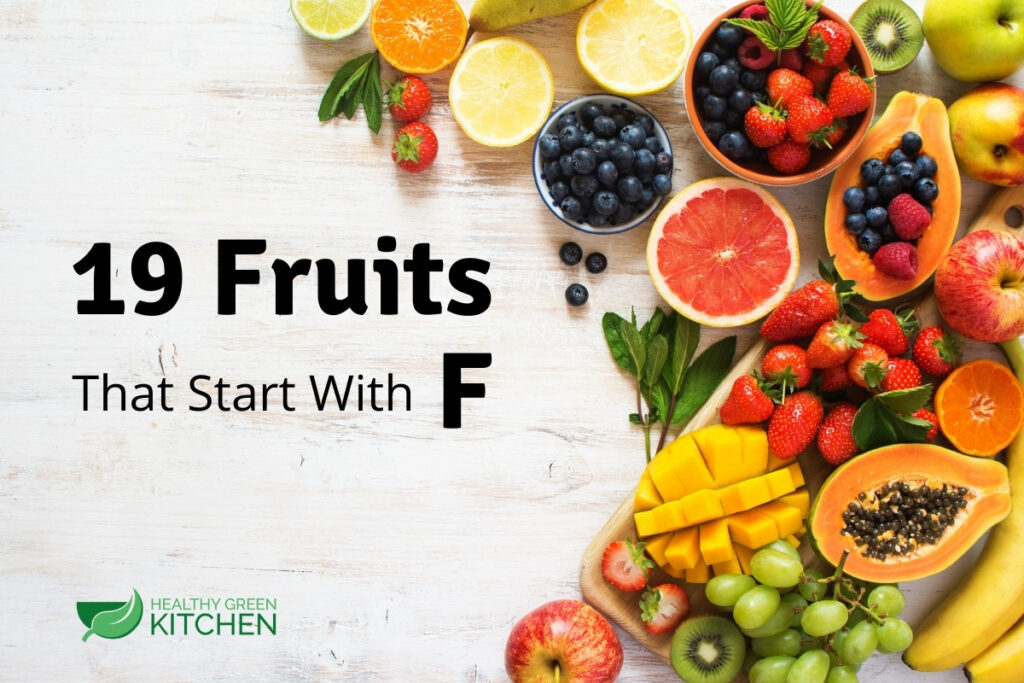
From the popular fuji apple to the obscure false mastic fruit, fruits that start with the letter F span the produce spectrum.
If you’re in the mood to try something new, or if you just appreciate some good alliteration, then join us on this frenetic journey to learn about some fantastic fruits that start with F.
Fruits that Start with the Letter F
1. Fairchild Tangerine
One of the most popular tangerine varieties, the Fairchild tangerine is a cross between the Orlando tangelo and the clementine mandarin.
These round fruits have deep orange skin that is harder to peel than other tangerines, but a rich, sweet flavor that is worth the fight. But proceed with caution, because there are a lot of seeds mixed in with that tasty flesh.
2. False Jaboticaba
False jaboticaba, also known as blue grape, is an evergreen tree native to Costa Rica, Venezuela, and other tropical countries in this area. It is related to the jaboticaba tree but produces larger fruit with thicker skin and a deep blue tinge.
False jaboticaba fruit is plum-sized with sweet grape-flavored flesh around one or two large seeds. They are typically eaten fresh or smashed and used in drinks.
3. False Mastic Fruit
Also known as the wild olive, false mastic fruit is about the size and shape of a large olive but has a distinct yellow color. They have a large pit in the center with gummy pulp surrounding it. When ripe, these fruits have a pleasantly sweet taste, but this quickly turns acidic and sour if left too long.
False mastic fruit trees are native to Florida and the Caribbean and are often used as decorative landscaping trees.
4. Fascell Mango
The Fascell mango was one of the first mango varieties to be patented in Florida. It was an intentional cross between the Haden and Brooks mangos in an attempt to fill the mango harvesting gap in June and July.
The somewhat heart-shaped yellow fruits have very sweet flesh that is fiberless and smooth. While not common in most grocers, this mango is widely cultivated across Florida for small commercial sale.
5. Fazli Mango
The Fazli mango is a large mango variety capable of reaching weights up to 2.2 pounds. The fruits retain a uniform pale green coloring for much of their growth until maturing into lime green to bright yellow when ripe. The flesh is sweet, low in fibers, and firm.
Fazlis are cultivated in Bangladesh and India and are exported throughout the world.
6. Fe’i Banana
Fe’i bananas are a distinct variety of banana found on the Pacific Islands. Their fruit, which has deep red or orange skin and yellow flesh, has been an important food source to native islanders for millennia and has followed them through the Pacific.
The many cultivators of fe’i banana are prepared like plantains and rarely eaten raw. Straight off the tree, they are somewhat astringent, but when baked or boiled they are deliciously flavorful and very nutritious.
7. Feijoa
Feijoa fruit resembles chicken eggs with avocado-like skin and a uniquely perfumy aroma. The gritty cream-colored flesh inside surrounds a gelatinous pulpy center. The flavor is also very unique, tasting something like a minty apple or pineapple.
These trees are native to eastern South America but have been cultivated as far north as Scotland. In warmer areas of the United States, Feijoa trees are sometimes used in decorative landscaping.
8. Fibrous Satinash Fruit
The red berries of the fibrous satinash fruit resemble large blueberries and grow in clusters similar to chokecherry. The flesh is sour and used almost exclusively for making jams.
Fibrous satinash fruit trees are native to Indonesia, Papua New Guinea, and Australia. The fruits are foraged by locals and the trees are sometimes grown as ornamental additions to yards.
9. Field Cucumber
Field cucumbers, also commonly known as slicers, are a variety of cucumber grown in fields rather than in greenhouses. These cultivators have thicker skin and contain seeds while greenhouse varieties, like English cucumbers, are thin skinned and usually do not have seeds.
Most cucumbers you find in the bin at the grocer are field cucumbers. Greenhouse varieties are easy to spot because they’re usually shrink-wrapped to protect their thinner skin from dehydration.
10. Fig
These ancient fruits are important in many religious ceremonies and are common throughout the world. The fruits of the fig are actually a conglomeration of hundreds of single-seeded fruits that develop inside a fleshy edible structure.
While the rumor that figs contain the bodies of dead wasps is true, rest assured that the wasp bodies have been fully decomposed by plant enzymes before they make it to your table. That crunchy texture the fig is famous for is actually the seeds of the individual fruits, not wasp body parts.
11. Finger Lime
Finger limes are a distant relative to true limes and other types of citrus. They are native to Australia and are commercially cultivated, though hard to find at grocers in the US.
The skin of the finger lime resembles that of a true lime, but the shape is elongated. The inside is made up of small juice-filled sacks, hence the fruit’s other name, caviar lime. They are available in green and pink varieties, both having a tart lime flavor with hints of astringent bitterness.
12. Five Flavor Berry
Five flavor berry, or magnolia berry, grow on viny plants native to North-Eastern Asia. The bright red clusters are prized for their beauty, uniquely complex sour-sweet flavor, and medicinal benefits.
The berries are often made into a tea and used to fight colds and prevent seasickness.
13. Flatwoods Plum
Flatwoods plum trees are often grown as ornamental trees prized for their early spring flowers. Small round reddish-purple fruits develop from those flowers.
While birds and animals flock to these nutritious fruits, their bitter flavor restricts their use to jellies and jams.
14. Florida Cherry
The adorable fruits of the Florida cherry resemble bite-sized pumpkins and mature through a range of colors from green to orange to reddish black. The less mature green and orange fruits are quite tart while the red and black fruits are deliciously sweet.
Florida cherry shrubs are native to South America but have been introduced to the state of their common namesake where they are now considered an invasive species.
15. Florida Strangler Fig
The Florida strangler fig is a parasitic viny plant that matures into a freestanding tree. It produces small yellow fruits that are nowhere near as large or flavorful as other fig species.
These bitter little fruits are eaten by wildlife, were an important food for early inhabitants of Florida and the Caribbean, and are still occasionally foraged by locals.
16. Forest Strawberries
Also known as woodland strawberries, forest strawberries are the wild cousin to commercially cultivated varieties. The fruits tend to be smaller than grocery store types, but the flavor is similar, if not better.
Some forest strawberry types are cultivated for jams, but most come by these sweet treats through foraging.
17. Fox Grape
The lesser-known Fox grape gave way to the popular Concord grape.
These dull purple-black fruits have a similar flavor to the Concord and are often used as table grapes, for jams and jellies, and for flavoring. They are also used to make wine.
18. Fuji Apple
As the name suggests, Fuji apples were first cultivated in Japan. They were made by crossing the Red Delicious with the Ralls Janet. Today, they are one of the nine most popular apples in the US.
Fuji apples are crisper than the Red Delicious and have sweet, juicy flesh reminiscent of bottled apple juice.
19. Fukushu Kumquat
The round, somewhat bell-shaped Fukushu kumquat doesn’t look like your typical kumquat. This variety originated from the chance hybrid of two closely related cultivators in Japan.
The flavor, which is similar to other kumquats, is on the sour side and fairly acidic.






